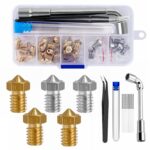
- arrow_back Home
- keyboard_arrow_right 3D Printers
Anycubic Leaking Hotend Issue (Hint, Open a Support Ticket)

3D Printers3D PrintingHow To's Chris Wyatt 24 October 2024
Ah, the dreaded hotend leak! A common frustration for 3D printing enthusiasts, especially Anycubic owners. Let’s troubleshoot this. Here’s a breakdown of the usual suspects and how to fix them:
Important Notes for Anycubic Owners:
- Specific Models: Some Anycubic models, like the Kobra, have had known issues with hotend leaks. Check Anycubic’s website or forums for potential recalls or replacement parts. As with the Anycubic Kobra 3 model, Anycubic are now replacing them with a new reenforced version. Just open a support ticket and upload a photo.
- Quick-Release Hotends: If you have a quick-release hotend, ensure it’s properly locked in place.
As for the other known issues with possible fixes see below.
1. Nozzle Issues:
- Loose Nozzle: This is the most frequent culprit. The nozzle needs to be snug against the heat break to create a proper seal.
- Fix: Heat the hotend to printing temperature. Carefully tighten the nozzle with the appropriate wrench while holding the heater block to prevent it from turning.
- Damaged Nozzle: A cracked or warped nozzle can cause leaks.
- Fix: Replace the nozzle with a new one.
2. Heat Break Problems:
- Loose Heat Break: The heat break needs to be firmly connected to both the heat sink and the heater block.
- Fix: Heat the hotend. Carefully tighten the heat break using two wrenches to prevent twisting and damage.
- PTFE Tube Issues (if applicable): If your hotend uses a PTFE tube, make sure it’s properly seated in the heat break and the nozzle. A gap or worn-out tube can cause leaks.
- Fix: Trim the PTFE tube for a clean end and ensure it sits flush against the nozzle. If it’s worn, replace it.
3. Heat Block Troubles:
- Loose Heat Block: If the heat block isn’t securely attached to the heat break, filament can leak.
- Fix: Heat the hotend. Tighten the heat block screws carefully.
4. Filament Issues:
- Incorrect Filament Diameter: Using a filament with a diameter that’s too large or too small can cause leaks.
- Fix: Use the correct filament diameter for your hotend.
- Wet Filament: Absorbed moisture in the filament can turn to steam in the hotend, causing pressure and leaks.
- Fix: Dry your filament using a filament dryer or a low-temperature oven.
5. Clogged Nozzle: A partially clogged nozzle can lead to pressure buildup and leaks. * Fix: Heat the hotend and use a cleaning needle to carefully clear any blockage.
6. Thermal Expansion: As the hotend heats up, the metal parts expand. Over-tightening when cold can lead to leaks when hot. * Fix: Tighten components when the hotend is at printing temperature.
If you’ve tried these steps and still have leaks, it’s best to:
- Consult Anycubic Support: They can provide specific guidance for your model and may offer replacement parts.
- Check Online Forums: Search for your specific Anycubic model and “hotend leak” to find solutions others have found.
Remember to be patient and methodical when troubleshooting. With a little detective work, you’ll have that hotend sealed and printing smoothly in no time!
About Ultimate 3D
Learn everything there is to know about 3D Printers and the different components and printing materials.
Site Links
Copyright 2024 Ultimate 3D





Be the first to leave a comment